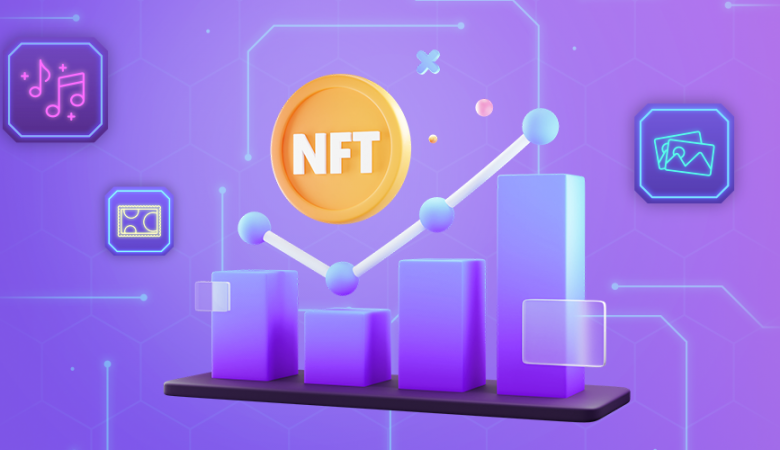We bet you have already heard all the best about NTFs: the fact that they can make a creator unfathomably rich or that, being digital, they are indestructible. Lots of these rumors must be elaborated upon. Let us go through the basics and proceed to the description of the NFT creation process, step by step.
How to make an NFT: the definition
You probably know what “NFT” stands for by now: it is a “non-fungible token”. These tokens are stored on blockchain and can be bought, sold, and transferred just like a digital coin. Check out our previous article for more details and examples.
How to make an NFT: a closer look
Under the hood, ERC-721 NFTs store a unique “tokenId” value: a 256-bit unsigned integer. The maximum value of that data type has so many digits it probably won’t fit into your phone screen.
The trick is to use tokenId’s to ensure an asset’s uniqueness and to transform the number into, say, a picture as necessary. Although each token must be unique, they can share the same smart contract.
How to create an NFT
Unfortunately, lots of people rush into cryptocurrencies misinformed and full of illusions. Exceptional NFTs are indeed expensive (we talk about thousands and millions of dollars) but to make and sell one for such a price, you have to possess a rare mixture of fame and technical skill—and artistic talent if you make NFT art. The law of supply and demand will do the rest.
A passerby will hardly make much money, left with an impression that the whole thing is a fraud.
How to create an NFT: get a wallet ready
There are many combinations of possible publishing platforms with their respective blockchains and cryptocurrency wallets. Ethereum paired with MetaMask have gained the most renown so far, so we will use them for the sake of example.
MetaMask is available as a browser extension or a mobile app: follow the installation guidelines and remember to store your secret key safe at all times.
Still, you should be aware of the less popular alternatives: Binance Smart Chain, Tezos, and NEAR blockchains have the working NFT publishing platforms, too. The minting and transaction prices, as well as the maximum possible NFT price, should be lower there.
Some of the non-Ethereum platforms, namely, are:
There are more of them, of course, the ones we are not aware about or the upcoming ones. Keep an eye on crypto news!
How to create an NFT: time to buy some crypto
As we just said, uploading an NFT to the Ethereum network is not free. By the way, the well-known services where you upload your awesome art are Rarible, SuperRare, Foundation, and OpenSea. They all support MetaMask connection and will ask for it at the stage of registration.
Ready to burn some gas? Then hit that “Create” button!
Oh wait, you need some ETH balance on the wallet first. You can buy it directly from MetaMask or send some from the existing wallet – we will gladly help with that.
The question is, how much ETH do you need, exactly, to publish your NFT? One of the Rarible users reported that it cost around $50 in Ether equivalent as of March 2021. Quite a substantial sum for an experiment, huh?
How to make a NFT: publishing options
Now that your NFT is ready to be uploaded and there’s enough Ether on the wallet balance, follow the creation steps: each of the platforms will have a slightly different workflow, so it is best to stick to the general suggestions.
How to make a NFT: what the publishing options may look like
Most customization buttons are self-explanatory:
Single or Multiple editions set the scarcity of your digital art piece.
Fixed price / Timed auction / Unlimited auction options go next.
This is where you must be extra attentive to avoid the following ridiculous situation: the fees consumed the low starting price and chewed up on your balance.
Title and Description text bars will represent your NFT verbally, so you better look up some examples by other creators to see their approaches. It takes creative talent to make it catchy.
Royalty percentage defines your returns every time an NFT is re-sold. A lower value will allow speculators to make more profit and motivate them to sell an asset, so consider leaving it the default 10%.
If you are not sure what the other options do, leave them as they are. Even better: read their detailed descriptions on the respective pages!
How to make a NFT: the original FAQ and Terms of Service are your best friends
Inexperienced newbies love asking the questions that have already been answered exhaustively in the FAQ section. The following risks are connected to it:
- Scammers deliberately misinform the users in order to siphon their crypto funds (through a MetaMask connection or other means).
- The other users who have skimmed through the Terms of Service—and misunderstood them—love sharing their advice, too. Naturally, the advice they share is far from perfect.
- The users who have actually read the official service pages and know the process in and out mock and mislead the newbies to “teach them a lesson”, forcing them to read the documentation.
The conclusion is obvious: don’t look for fast and simple answers, grind through the documentation and address the community managers for clarifications. This one is rock-solid advice that will save you a lot of trouble, regardless of a blockchain or publishing platform.
How to create a NFT
As soon as you develop a habit of reading everything related to a certain project before jumping headlong into it, it starts to feel like a rabbit hole.
How to create a NFT: technical subtleties
Smart contracts are extremely flexible in managing digital assets. For example, instead of the usual royalty system, Etherpoems uses a contract that distributes earnings between all the platform users if one of them makes a sale.
Learning to distinguish between IPFS and on-chain storage might be of no practical use for you at the moment, yet it will help to spot promising technologies and the respective tokens in the long run.
It is good to know that layer-two (L2) solutions, like Polygon (MATIC) or Harmony (ONE), are on their way to lower the transaction fees or eliminate them altogether, so watch the mentioned technologies and their analogues closely.
Finally, if you aim for multiverse game assets, make your NFT an ERC-1155 instead of the traditional ERC-721 standard for art pieces. The minted ERC-1155 assets can be melted back for the amount of coins they were initially “imbued” with.
How to create a NFT: do you even need to?
It takes money to make money, so if you treat NFTs solely as a moneymaking venture, be ready to take the financial risks. Why not buy and hold instead, then?
NFTs are widely used as a way to commemorate events, mark achievements, showcase one’s skills, or just for fun. Anyway, considering volatility and emotional tension on the market, it is better to take them lightheartedly.





Leave a Reply